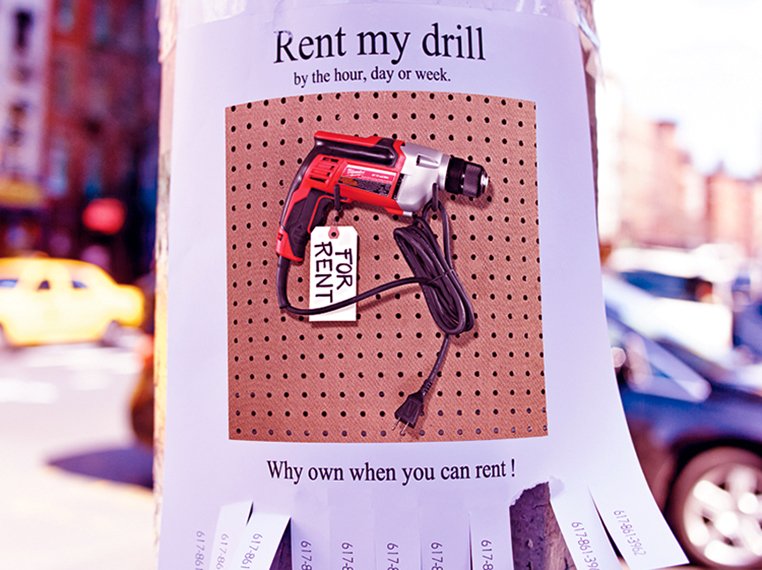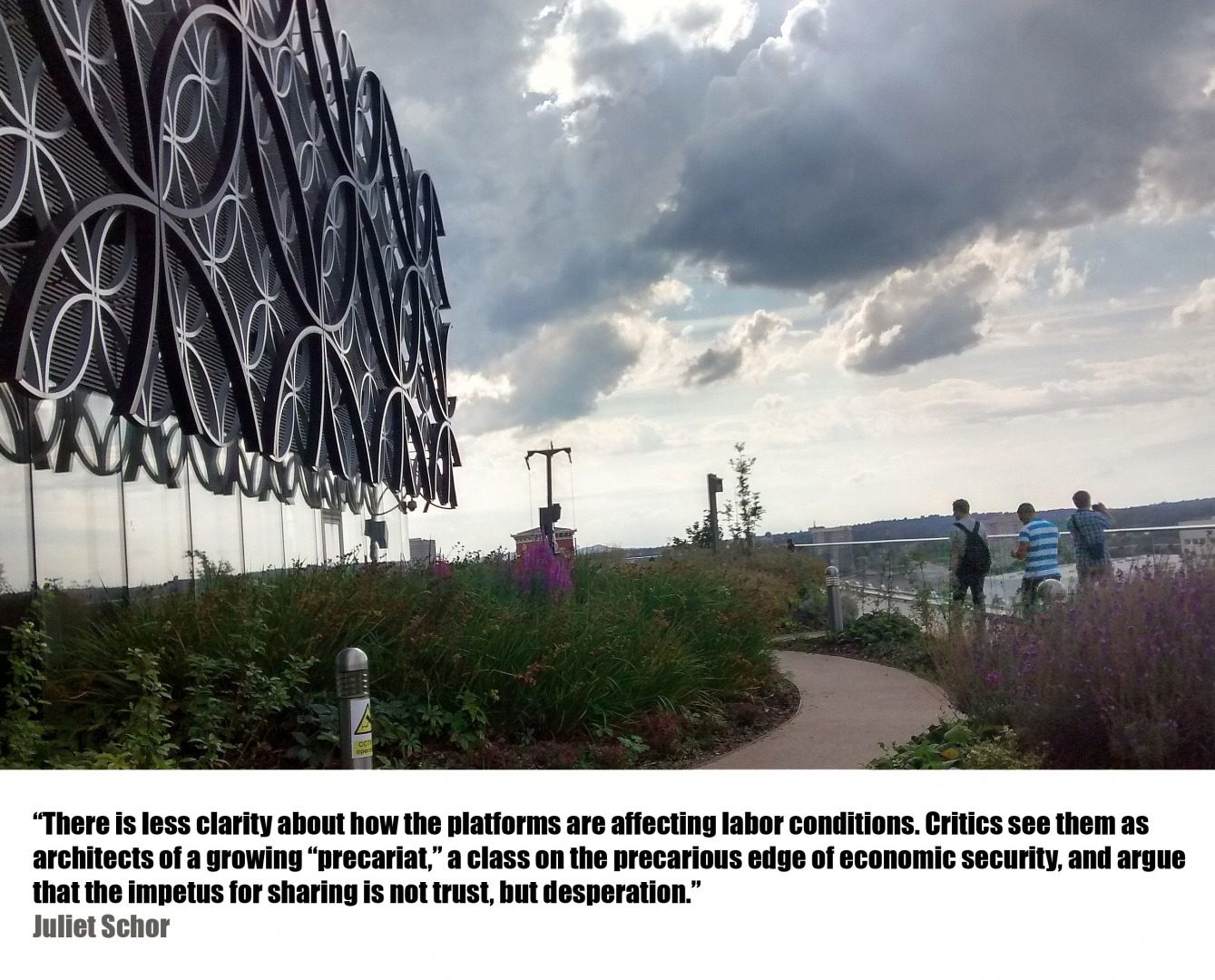
Exploiting Labor?
The debut of the sharing economy was marked by plenty of language about doing good, building social connections, saving the environment, and providing economic benefits to ordinary people. It was a feel-good story in which technological and economic innovation ushered in a better economic model. Especially in the aftermath of the financial crash, this positive narrative was hard to resist. Social activists flocked to these initiatives, hoping to piggyback on their popularity. Maybe, they thought, digital P2P platforms could be a pathway to a true grassroots, inclusive, fair, and low impact economy.
Dean Baker, a progressive economist, claims the new sharing is “largely based on evading regulations and breaking the law” and subjects consumers to a substandard, possibly unsafe product.[19. Dean Baker, “Don’t Buy the ‘Sharing Economy’ Hype: Aibnb and Uber Are Facilitating Ripoffs,” The Guardian, May 27, 2014, Anthony Kalamar has called out “sharewashing,” in which platforms shift risk onto employees under the guise of “sharing.”[20. Anthony Kalamar, “Sharewashing is the New Greenwashing,” OpEd News, May 13, 2013, Tom Slee, writing in Jacobin, has challenged Airbnb’s claim that its users are single individuals earning small amounts of extra money, finding that half the revenue generated in New York City accrues to hosts with multiple listings.[21. Tom Slee, “Sharing and Caring,” Jacobin Magazine, January 24, 2014, . com/2014/01/sharing-and-caring/.]
The central theme of the critics is that for-profit platforms have coopted what began as a progressive, socially transformative idea. Are they right? Regarding regulation, insurance, and taxation, the platforms are mobilizing political support, and, my experience suggests that they seem to be generally accepting of the idea that some regulation is necessary. Because most of the action is at the local and state level, there is a great deal of variation. But the trend seems to be towards a light regulatory touch that will allow the platforms to operate and grow.
There is less clarity about how the platforms are affecting labor conditions. Critics see them as architects of a growing “precariat,” a class on the precarious edge of economic security, and argue that the impetus for sharing is not trust, but desperation.[22. Kevin Roose, “The Sharing Economy Isn’t About Trust, It’s About Desperation,” New York Magazine, April 24, 2014, From the perspective of drivers, errand-runners, and hosts, they describe a race to the bottom, with risk-shifting from companies to individual “microentrepreneurs.”
Part of the difficulty in assessing the impact of these new earning opportunities is that they are being introduced during a period of high unemployment and rapid labor market restructuring. Working conditions and protections are already being eroded, real wages are declining, and labor’s share of national income in the US has declined to historic lows. If the labor market continues to worsen for workers, their conditions will continue to erode, and it will not be because of sharing opportunities. Alternatively, if labor markets improve, sharers can demand more of the platforms because they have better alternatives. The two effects will work in opposite directions: with destruction of demand for legacy businesses and growth for sharing companies.
We also need to consider the diversity of industries in which sharing platforms are operating. Some sectors are characterized by high rents that are easy to capture with disruptive technologies. Consider taxis. The biggest impact is likely the erosion in the value of medallions, the licenses they must possess to operate, because these medallions yield pure rents. While drivers in conventional operations may be capturing some of this excess profit, they are already facing adverse market conditions and, in many places, earning low hourly wages, as they are forced to pay high leasing and other fees to the owners of the medallions and vehicles. Union members fare better, but could they do better with Uber? Many have switched in hopes that they can. So far, though, the results are mixed, in part because they face increasing competition from platforms like UberX and Lyft, on which drivers use their own cars. And early high returns have been reduced by Uber’s fare cuts, which have led to driver protests and organizing efforts.

An online platform with a good rating system should improve labor conditions. Consider the market for home health aides, where agencies currently take an enormous fraction of hourly fees, sometimes more than half.[23. Jane Gross, “Home Health Aides: What They Make, What They Cost,” New York Times, December 30, 2008, A P2P matching platform would take a lower fraction, enabling low-paid workers to earn considerably more and have more autonomy over which jobs they accept. Where owners, agencies, or other actors are extracting rents, P2P platforms should do what they claim—distribute value to consumers and producers and away from gatekeepers and rent extractors.
Ultimately, the question is about how much value providers on these platforms can capture. This depends partly on whether they can organize themselves, a question the next section will explore. But there is another dimension, which is whether there is competition among platforms. Will they come to monopolize a given space, as we have seen in the areas of search, social media, and retail (Google, Facebook, Amazon)? Or are these P2P enterprises different? What they are offering is software, insurance, ratings, and a critical mass of participants. These are functions that can be replicated. For example, if the volume of users continues to grow, then critical mass may be achievable on multiple platforms. The ratings systems are not yet very good, and there are already start-ups attempting to delink ratings from individual platforms. Insurance can also be unbundled. At the May conference, venture capitalist Brad Burnham predicted a coming round of cost-squeezing akin to the cost-squeezing that the start-ups are inflicting on legacy businesses. On the other hand, the more the platforms are backed by and integrated with the large corporations that dominate the economy, the more monopolized the sector will be, and the less likely value will flow to providers and consumers.
Organized Sharers?
An alternative to the co-optation path is one in which sharing entities become part of a larger movement that seeks to redistribute wealth and foster participation, ecological protection, and social connection. This will only happen via organization, even unionization, of users. Indeed, the question of whether providers should organize is now firmly on the table, although it is too early to know how things will evolve.[24. Uber and Lyft drivers have begun unionization efforts in various cities. Union representatives were at the San Francisco conference, and unionization has emerged as a topic of conversation among sharing innovators. This year, the National Freelancers’ Union opened a benefits desk offering insurance, 401(k) plans and other benefits for “independent” laborers in a variety of companies, including Lyft.]
Airbnb has begun to encourage its users to organize. In 2013, the global head of “community” at the company co-founded Peers.org, an attempt to build a social movement of sharers. Not long after, Airbnb created its own organizing platform for guests, hosts, and employees, which has led to the creation of numerous local groups of users who are coming together on and offline for a variety of purposes, including sharing advice and affecting public policy. The company wants these groups to push for favorable regulation. But they may develop agendas of their own, including making demands of the company itself, such as setting price floors for providers, pushing risk back onto the platforms, or reducing excessive returns to the entrepreneurs and the venture capitalists. On the labor exchanges, where the need for organization is perhaps most acute, providers could push for minimum wages.
Existing platforms could also potentially become user-governed or cooperatively owned, an outcome some voices within the community are advocating. The platforms’ discourse borrows heavily from the peer production world and emphasizes the ability of these technologies to empower ordinary individuals. As many online communities have shown, the online environment can be conducive to organizing against unpopular policies, software changes, and practices. The fact that users create so much of the value in these spaces militates in favor of their being able to capture it, should they organize to do so. To date, that type of movement has not developed, but it still might.
Alternately, organizations that are part of the solidarity sector, such as unions, churches, civil society groups, and cooperatives, could create platforms for their members. They could build alternatives to the for-profits, particularly if the software to operate these exchanges is not too expensive. These platforms could be usergoverned and/or owned. For example, a taxi cooperative in Portland, Oregon, has adopted the technology used by ride sharing companies and will effectively morph into a driver-owned Lyft or Uber. In general, mounting a competitive challenge to business-as-usual should be easier when production is P2P because the platform is a broker, not a producer. This is one of the reasons the sharing platforms have grown so rapidly, while efforts to create worker cooperatives have yielded so few new enterprises and jobs. In the end, though, it is not just about economics. The key to making sharing economies socially just is to emphasize an explicit politics of sharing, as well as nurturing collective, public forms of sharing.
Conclusion: Creating a Movement
So what are we to make of the sharing economy? There is little doubt that the pro sharing discourse is blind to the dark side of these innovations. At the same time, the critics are too cynical. There is potential in this sector for creating new businesses that allocate value more fairly, that are more democratically organized, that reduce eco-footprints, and that can bring people together in new ways. That is why there has been so much excitement about the sharing economy. The emergence of P2P communities that share goods, space, and labor services can be the foundation of a new household model in which people are less dependent on employers and more able to diversify their access to income, goods, and services. But the early stage goodwill from the big platforms will dissipate as they become incorporated into the business-as-usual economy. We are at a critical juncture in which users’ organizing for fair treatment, demands for eco-accountability, and attention to whether human connections are strengthened through these technologies can make a critical difference in realizing the potential of the sharing model. There is an enormous amount of new economic value being created in this space. It is imperative that it flow equitably to all participants. After all, that is what we ordinarily call sharing.
Ultimately, the ability of the new sharing practices to help catalyze a social transition may also depend on the form these initiatives take around the world. As the sharing economy expands in Europe, its practices are likely to be embedded in political, regulatory, and social contexts which are more attuned to the stated values of fairness, sustainability, openness, and cooperation. In Latin America, the leftward shift toward social solidarity, poverty alleviation, and democracy also suggests a context more conducive to a cooperative and community-oriented sharing movement, as we have seen in Ecuador. For those of us in countries where the pressures to commodify and concentrate value from these platforms are most intense, these developments can reveal possibilities.
Outside the US, the impetus to share in transportation, housing, foods, and goods is more integrally tied to city-level goals of carbon emission reduction, informational transparency and genuine democracy. By embedding sharing practices within those larger municipal level movements, the likelihood that the sharing movement can achieve its stated goals is greater. My hunch is that the more that US sharing activists connect with other sharers around the globe, the more success we will have in pushing the goals of eco-accountability, value distribution, and social solidarity. This also means an openness to and ideally connection with other social movements that are already active on these issues. Ultimately, a cross-fertilization could both create accountability for the sharing platforms and organizations and embed sharing practices and cooperative economic activity into the DNA of the social movements.
The sharing economy has been propelled by exciting new technologies. The ease with which individuals, even strangers, can now connect, exchange, share information, and cooperate is truly transformative. That’s the promise of the sharing platforms about which virtually everyone agrees. But technologies are only as good as the political and social context in which they are employed. Software, crowdsourcing, and the information commons give us powerful tools for building social solidarity, democracy, and sustainability. Now our task is to build a movement to harness that power.
Debating the sharing economy Part 1
Debating The Sharing Economy Part 2
Article first published at website Great Transition Initiative
Endnotes
Juliet Schor is Professor of Sociology at Boston. She is also a member of the MacArthur Foundation Connected Learning Research Network. Schor’s research focuses on issues of time use, consumption and environmental sustainability. A graduate of Wesleyan University, Schor received her Ph.D. in economics at the University of Massachusetts. Before joining Boston College, she taught at Harvard University for 17 years, in the Department of Economics and the Committee on Degrees in Women’s Studies. In 2014 Schor received the American Sociological Association’s award for Public Understanding of Sociology. She also served as the Matina S. Horner Distinguished Visiting Professor at the Radcliffe Institute at Harvard University.
Schor is a former Guggenheim Fellow and recipient of the 2011 Herman Daly Award from the US Society for Ecological Economics. She is a former Trustee of Wesleyan University, an occasional faculty member at Schumacher College, and a former fellow of the Brookings Institution.
She is a co-founder of the Center for a New American Dream (newdream.org), a national sustainability organization where she served on the board for more than 15 years. She is also on the board of the Better Future Project, one of the country’s most successful climate activism organizations. She is a co-founder of the South End Press and the Center for Popular Economics.
Schor has lectured widely throughout the United States, Europe and Japan to a variety of civic, business, labor and academic groups. She appears frequently on national and international media, and profiles on her and her work have appeared in scores of magazines and newspapers, including The New York Times, Wall Street Journal, Newsweek, and People magazine. She has appeared on 60 Minutes, the Today Show, Good Morning America, The Early Show on CBS, numerous stories on network news, as well as many other television and radio news programs.































